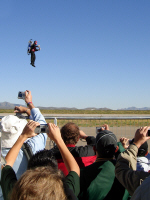
X PRIZE Cup
Encyclopedia

Jet pack
Jet pack, rocket belt, rocket pack, and similar names are various types of devices, usually worn on the back, that are propelled by jets of escaping gases so as to allow a single user to fly....
s; but particularly notable are the Lunar Lander Challenge and the Space Elevator Games. 85,000 visitors attended the 2007 X Prize Cup. Although there was no X Prize Cup in 2009, there was a Lunar Lander Challenge.
Motivation

Peter Diamandis
Dr. Peter H. Diamandis , of Greek immigrant parents, is considered a key figure in the development of the personal spaceflight industry, having created many space-related businesses or organizations...
in an address to the NSS
National Space Society
The National Space Society is an international nonprofit 501, educational, and scientific organization specializing in space advocacy...
International Space Development Conference
International Space Development Conference
The International Space Development Conference is the annual conference of the National Space Society . Now in its 30th year, these conferences connect the general public and the NSS membership with leaders of contemporary space efforts...
in 1995. The notion of a competitive goal was adopted from the SpaceCub
SpaceCub
SpaceCub was a design project for a homebuilt rocket. Between 1993 and 1994, Geoffrey A. Landis proposed that a vehicle designed to launch to the edge of space might be a feasible project for a "personal" spaceship, the equivalent of a Piper Cub for space...
project, demonstration of a private vehicle capable of flying a pilot to the edge of space, defined as 100 km altitude. This goal was selected to help encourage the space industry in the private sector
Private sector
In economics, the private sector is that part of the economy, sometimes referred to as the citizen sector, which is run by private individuals or groups, usually as a means of enterprise for profit, and is not controlled by the state...
, which is why the entries were not allowed to have any government funding. It aimed to demonstrate that spaceflight
Spaceflight
Spaceflight is the act of travelling into or through outer space. Spaceflight can occur with spacecraft which may, or may not, have humans on board. Examples of human spaceflight include the Russian Soyuz program, the U.S. Space shuttle program, as well as the ongoing International Space Station...
can be affordable and accessible to corporations and civilians, opening the door to commercial spaceflight
Private spaceflight
Private spaceflight is flight above Earth altitude conducted by and paid for by an entity other than a government. In the early decades of the Space Age, the government space agencies of the Soviet Union and United States pioneered space technology augmented by collaboration with affiliated design...
and space tourism
Space tourism
Space Tourism is space travel for recreational, leisure or business purposes. A number of startup companies have sprung up in recent years, hoping to create a space tourism industry...
. It is also hoped that competition will breed innovation
Innovation
Innovation is the creation of better or more effective products, processes, technologies, or ideas that are accepted by markets, governments, and society...
, introducing new low-cost methods of reaching Earth orbit.
The X Prize was modeled after many prizes from the early 20th century that helped prod the development of air flight
Flight
Flight is the process by which an object moves either through an atmosphere or beyond it by generating lift or propulsive thrust, or aerostatically using buoyancy, or by simple ballistic movement....
, including most notably the $25,000 Orteig Prize
Orteig Prize
The Orteig Prize was a $25,000 reward offered on May 19, 1919, by New York hotel owner Raymond Orteig to the first allied aviator to fly non-stop from New York City to Paris or vice-versa. On offer for five years, it attracted no competitors...
that spurred Charles Lindbergh
Charles Lindbergh
Charles Augustus Lindbergh was an American aviator, author, inventor, explorer, and social activist.Lindbergh, a 25-year-old U.S...
to make his solo flight across the Atlantic Ocean
Atlantic Ocean
The Atlantic Ocean is the second-largest of the world's oceanic divisions. With a total area of about , it covers approximately 20% of the Earth's surface and about 26% of its water surface area...
. NASA
NASA
The National Aeronautics and Space Administration is the agency of the United States government that is responsible for the nation's civilian space program and for aeronautics and aerospace research...
is developing similar prize programs called Centennial Challenges
Centennial Challenges
The Centennial Challenges are NASA space competition prize contests for non-government-funded technological achievements by American teams.-Current Challenges:...
to generate innovative solutions to space technology
Space technology
Space technology is technology that is related to entering, and retrieving objects or life forms from space."Every day" technologies such as weather forecasting, remote sensing, GPS systems, satellite television, and some long distance communications systems critically rely on space infrastructure...
problems.
The X Prize Cup continues the mission to push private enterprise towards innovative solutions, by offering monetary rewards and organizational support to the community of aerospace professionals—and by staging Earth's great space exposition.
2004 Ansari X Prize
The original Ansari X Prize was a US$United States dollar
The United States dollar , also referred to as the American dollar, is the official currency of the United States of America. It is divided into 100 smaller units called cents or pennies....
10,000,000 prize
Prize
A prize is an award to be given to a person or a group of people to recognise and reward actions or achievements. Official prizes often involve monetary rewards as well as the fame that comes with them...
, offered by the X Prize Foundation
X Prize Foundation
The X PRIZE Foundation is a non-profit organization that designs and manages public competitions intended to encourage technological development that could benefit mankind....
, for the first non-government organization
Non-governmental organization
A non-governmental organization is a legally constituted organization created by natural or legal persons that operates independently from any government. The term originated from the United Nations , and is normally used to refer to organizations that do not form part of the government and are...
to launch a reusable manned spacecraft into space
Outer space
Outer space is the void that exists between celestial bodies, including the Earth. It is not completely empty, but consists of a hard vacuum containing a low density of particles: predominantly a plasma of hydrogen and helium, as well as electromagnetic radiation, magnetic fields, and neutrinos....
twice within two weeks. It was modeled after early 20th-century aviation
Aviation
Aviation is the design, development, production, operation, and use of aircraft, especially heavier-than-air aircraft. Aviation is derived from avis, the Latin word for bird.-History:...
prizes, and aimed to spur development of low-cost spaceflight. The prize was won on October 4, 2004, the 47th anniversary of the Sputnik 1
Sputnik 1
Sputnik 1 ) was the first artificial satellite to be put into Earth's orbit. It was launched into an elliptical low Earth orbit by the Soviet Union on 4 October 1957. The unanticipated announcement of Sputnik 1s success precipitated the Sputnik crisis in the United States and ignited the Space...
launch, by the Tier One
Tier One
Tier One is Scaled Composites' program of suborbital human spaceflight using the reusable spacecraft SpaceShipOne and its launcher White Knight. The craft was designed by Burt Rutan, and the project is funded 20 million US Dollars by Paul Allen...
project using the experimental spaceplane
Spaceplane
A spaceplane is a vehicle that operates as an aircraft in Earth's atmosphere, as well as a spacecraft when it is in space. It combines features of an aircraft and a spacecraft, which can be thought of as an aircraft that can endure and maneuver in the vacuum of space or likewise a spacecraft that...
SpaceShipOne.
The success and popularity of this event lead to the following events which were called the X-PRIZE Cup.
2006 Wirefly X Prize Cup

Las Cruces, New Mexico
Las Cruces, also known as "The City of the Crosses", is the county seat of Doña Ana County, New Mexico, United States. The population was 97,618 in 2010 according to the 2010 Census, making it the second largest city in the state....
, and represented an effort by the X Prize Foundation to continue encouraging innovation in the private sector. The 2006 Wirefly
InPhonic
InPhonic Inc was an American company which sold wireless services and devices online, both through its own electronic commerce sites and through private labeled websites it created and managed for online retailers. InPhonic was founded by David A. Steinberg who resigned in 2007 due to poor debt...
X Prize Cup focused on rocketry and lunar landing technology, offered up $2.5 million in prizes to teams competing in several distinct competitions related to the general theme. The exposition also featured high-powered rocket launches and exhibits intended to boost public interest in aerospace technology. In December 2006, the Cup's organizers announced expansion plans based on the success of the October event.
With the success of the original X Prize competition, the open competitions for $2.5 million in monetary prizes were the highlight of the 2006 Wirefly X Prize Cup. The aerospace teams in Las Cruces
Las Cruces
Las Cruces could refer to:* Battle of Monte de las Cruces* Las Cruces, California* Las Cruces, Chile* Las Cruces, New Mexico ** The main campus of New Mexico State University...
fought for the top prize in three events—the Lunar Lander Challenge, the Vertical Rocket Challenge, and the Space Elevator Games.
In addition to the featured competitions, the Wirefly X Prize Cup included a series of rocket
Rocket
A rocket is a missile, spacecraft, aircraft or other vehicle which obtains thrust from a rocket engine. In all rockets, the exhaust is formed entirely from propellants carried within the rocket before use. Rocket engines work by action and reaction...
ry exhibitions and educational presentations. "Rocketman" Dan Schlund demonstrated his "Rocketbelt," a device which allows him to soar above the earth with a rocket strapped to his back. The Rocket Racing League
Rocket Racing League
The Rocket Racing League is a proposed racing league that would use rocket-powered aircraft to race a closed-circuit air racetrack. Founded in 2005, the league is currently working to hold the first multi-vehicle races in 2011...
debuted the Mark-1 X-Racer, a preview of next-generation motor sports. Other attractions included high-powered rocket launches, a student competition, a symposium on personal spaceflight
Spaceflight
Spaceflight is the act of travelling into or through outer space. Spaceflight can occur with spacecraft which may, or may not, have humans on board. Examples of human spaceflight include the Russian Soyuz program, the U.S. Space shuttle program, as well as the ongoing International Space Station...
, and an assortment of ground displays and simulators.
2007 X Prize Cup
The 2007 X Prize Cup, was held at Holloman Air Force BaseHolloman Air Force Base
Holloman Air Force Base is a United States Air Force base located six miles southwest of the central business district of Alamogordo, a city in Otero County, New Mexico, United States. The base was named in honor of Col. George V. Holloman, a pioneer in guided missile research...
in Alamogordo, NM, on October 26–28. The 2007 X Prize Cup also marked the rebirth of the Teacher in Space Project
Teacher in Space Project
The Teacher in Space Project was a NASA program announced by Ronald Reagan in 1984 designed to inspire students, honor teachers, and spur interest in mathematics, science, and space exploration....
, when the Space Frontier Foundation and the United States Rocket Academy announced the competition rules and begin accepting applications for the first Teacher in Space "pathfinder". Aircraft as well as rockets were featured at the event, along with the Lunar Lander Challenge. 85,000 people attended the event.
Lunar Lander Challenge Prize not claimed
The Armadillo AerospaceArmadillo Aerospace
Armadillo Aerospace is an aerospace startup company based in Mesquite, Texas. Its initial goal is to build a manned suborbital spacecraft capable of space tourism, but it has stated long-term ambitions of orbital spaceflight. The company was founded by John Carmack.On October 24, 2008, Armadillo...
team successfully completed the first of two legs of the $350,000 prize Level 1 challenge on 27 Oct 2007 by completing a flight above 50 m altitude and moving horizontally to a second pad for landing after more than 90 seconds of flight time. The prize was not claimed in 2007 however as the rocket engine
Rocket engine
A rocket engine, or simply "rocket", is a jet engineRocket Propulsion Elements; 7th edition- chapter 1 that uses only propellant mass for forming its high speed propulsive jet. Rocket engines are reaction engines and obtain thrust in accordance with Newton's third law...
experienced a hard start
Hard start
A hard start is a rocketry term referring to an overpressure condition during start of a rocket engine at ignition. In the worst cases this takes the form of an explosion.-Rocket ignition:...
on the second leg return flight, resulting in a cracked engine, excessive loss of fuel, and an inability to remain in the air for the full 90 seconds required. No other competitor was able to achieve even a successful first leg of the competition.
Northrop Grumman Lunar Lander Challenge
The Northrop Grumman Lunar Lander Challenge (NG-LLC) is intended to accelerate the commercial development of a vehicle capable of launching from surface of the Moon to lunar orbit and back. The competition is part of NASA's Centennial Challenges program. Such a vehicle would have direct application to NASA's space exploration goals as well as the personal spaceflight industry. The prize may also help the industry build new vehicles and develop the operational capacity to operate quick turnaround vertical take-off, vertical landing vehicles.
To win, the team's rocket must take-off vertically, climb at least 50 meters above the pad, fly for a minimum amount of time and land on a target that is 100 meters from the takeoff point. The team can then refuel the rocket, which must then fly back to the original pad. There are two levels to the competition. In Level 1 the vehicle must be in the air on each leg for 90 seconds. A $350,000 prize is given to the first successful team, and $150,000 to the second. In Level 2 the vehicle must be in the air on each leg for 180 seconds to win the $1 million prize.
Space Elevator Games
In 2006, the Space Elevator Games took place at the Wirefly X Prize Cup. A space elevatorSpace elevator
A space elevator, also known as a geostationary orbital tether or a beanstalk, is a proposed non-rocket spacelaunch structure...
is a theoretical system using a super-strong ribbon going from the surface of the Earth to a point beyond geosynchronous orbit. The ribbon is held in place by a counterweight in orbit. As the Earth rotates, the ribbon is held taut. Vehicles would climb the ribbon powered by a beam of energy projected from the surface of the Earth. Building a space elevator requires materials and techniques that do not currently exist. The Space Elevator Games are meant to stimulate the development of such materials and techniques.
The games are divided into two categories: the Power Beam Challenge and the Tether
Tether
A tether is a cord, fixture, or signal that anchors something movable to a reference point which may be fixed or moving. There are a number of applications for tethers: balloons, kites, tethered wind-energy conversion systems, anchors, tethered water-flow energy conversion systems, towing, animal...
Challenge. In the Power Beam Challenge, each team designs and builds a climber (a machine capable of traveling up and down a tether ribbon). The climber must carry a payload. Power will be beamed from a transmitter to a receiver on the climber. Each climber must travel to a height of 50 meters traveling a minimum speed of 1 meter per second. The Tether Challenge is to help develop very strong tether material for use in various structural applications.
The 2007 Space Elevator Games were not held at the Wirefly X Prize Cup. Instead, they took place in Salt Lake City.
Pete Conrad Spirit Award
The Pete Conrad Spirit Award, instituted in 2007 and named for American astronautAstronaut
An astronaut or cosmonaut is a person trained by a human spaceflight program to command, pilot, or serve as a crew member of a spacecraft....
Pete Conrad
Pete Conrad
Charles "Pete" Conrad, Jr. was an American naval officer, astronaut and engineer, and the third person to walk on the Moon during the Apollo 12 mission. He set an eight-day space endurance record along with command pilot Gordon Cooper on the Gemini 5 mission, and commanded the Gemini 11 mission...
, is given to students between the ages of 13 and 18 that develop a new concept to benefit the personal spaceflight industry. This award was presented to the finalists at the 2007 X Prize Cup.
Organization
With the Ansari X Prize, the X Prize Foundation (based in Santa Monica, CA) established a philanthropic model in which offering a prize for achieving a specific goal stimulates entrepreneurial investment that produces a 10 times or greater return on the prize purse and at least 100 times in follow-on investment and social benefit. The Foundation has developed into a non-profit prize institute that conceives, designs and manages public competitions for the benefit of humanity.See also
- Progressive Insurance Automotive X Prize
- NASA Centennial ChallengesCentennial ChallengesThe Centennial Challenges are NASA space competition prize contests for non-government-funded technological achievements by American teams.-Current Challenges:...
- List of prizes
- Prizes named after peoplePrizes named after peopleThis is a list of prizes that are named after people.For other lists of eponyms see Lists of etymologies.* Ansari X Prize - Anousheh Ansari, Amir Ansari* Prince of Asturias Awards - Felipe, Prince of Asturias-A:...
- America's Space PrizeAmerica's Space PrizeAmerica's Space Prize was a US$50 million space competition in orbital spaceflight established and funded in 2004 by hotel entrepreneur Robert Bigelow. The prize would have been awarded to the first US-based privately-funded team to design and build a reusable manned capsule capable of flying 5...
- Methuselah Mouse Prize, or M Prize (modelled after the Ansari X Prize)
- Space Ship One
Related technical topics:
- Specific impulseSpecific impulseSpecific impulse is a way to describe the efficiency of rocket and jet engines. It represents the derivative of the impulse with respect to amount of propellant used, i.e., the thrust divided by the amount of propellant used per unit time. If the "amount" of propellant is given in terms of mass ,...
- Tsiolkovsky equation
- Delta V
External links
- X Prize Cup official site
- Wirefly's X Prize Cup blog
- X Prize founder talks about the prize and the future of space travel (MIT Video)
- FAI Rules for Astronautic Record Attempts
- Google Earth 3D modeling of Wirefly X Prize Cup events
- A video presentation focusing on the 2006 Wirefly X Prize Cup is available on YouTube.
- A Video of Rocketman during one of his three flights

